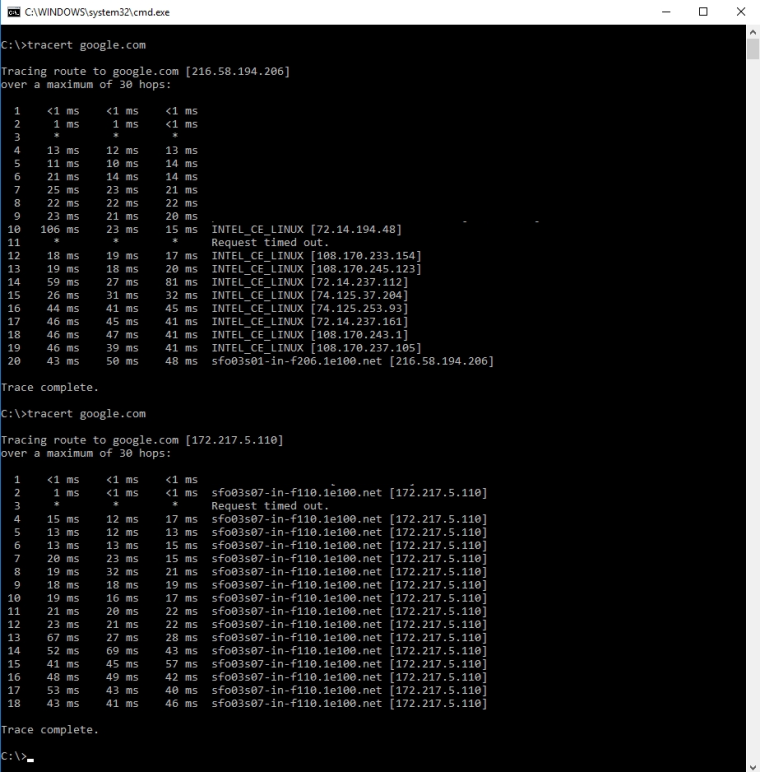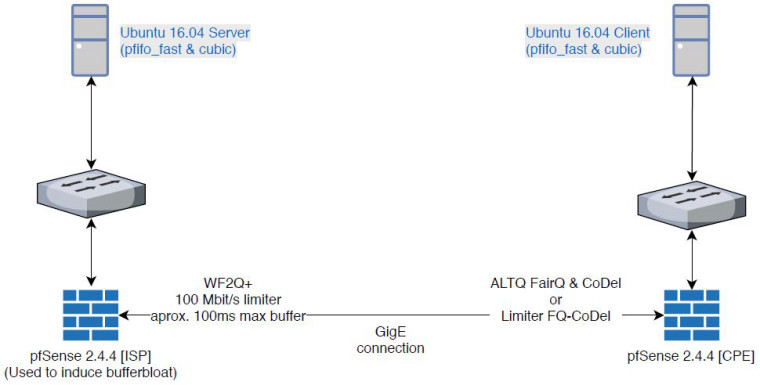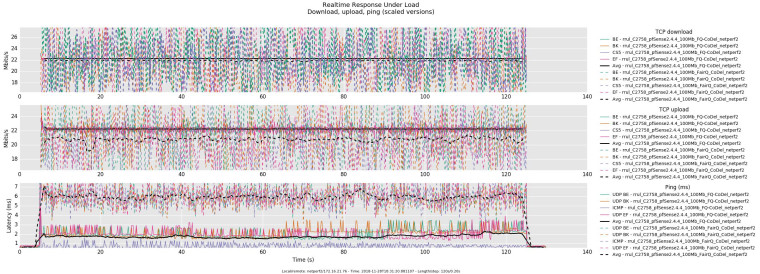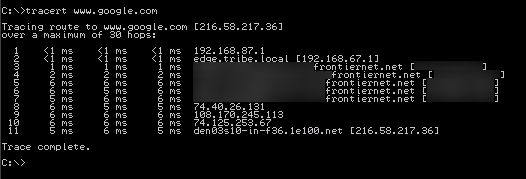Playing with fq_codel in 2.4
-
-
@gsmornot I'm glad you're getting all A+ on dslreports.com/speedtest but you traffic shaper is not configured properly IMO. You are letting your ISP manage your WAN ingress buffers or the interface buffers on your firewall are being used. You are only shaping out from WAN.
I'll update this post with graphs to help illustrate my point.
-
The first tracert is what I get with ICMP rule on top of floating as pass quick any and the 2nd tracert is what I get with the same rule as match, quick, any. With match the host name even resolves differently. Perhaps you aren't showing all of your floating rules and their order.

-
@markn6262
1.) What you are seeing in the first example you posted looks to be a properly behaving icmp trace. If you look at my example you will notice that I created a pass quick ICMP Traceroute floating rule in the first position. Maybe you read it as match only?
2.) The second example shows the "loop" folks were talking about earlier in this thread. All of the hops are being listed as the end node. The TTL is not being decreased due to policy routing.
3.) I'm showing all of the floating rules in my example. -
@uptownvagrant My first reply was to @wgstarks. I further replied to your post because I thought your position was in agreement with @wgstarks that a match rule is what is required. Miscommunication.
-
@markn6262 said in Playing with fq_codel in 2.4:
@uptownvagrant My first reply was to @wgstarks. I further replied to your post because I thought your position was in agreement with @wgstarks that a match rule is what is required. Miscommunication.
Ok. Just because I am easily confused
 , I'ld like to confirm that this should be a pass quick and not a match quick?
, I'ld like to confirm that this should be a pass quick and not a match quick? -
@uptownvagrant said in Playing with fq_codel in 2.4:
@gsmornot I'm glad you're getting all A+ on dslreports.com/speedtest but you traffic shaper is not configured properly IMO. You are letting your ISP manage your WAN ingress buffers or the interface buffers on your firewall are being used. You are only shaping out from WAN.
I'll update this post with graphs to help illustrate my point.
I follow you. I do it on purpose because the ingress results are not an issue for me. I assume the slowest part of my link is upstream from me so no shaping needed. I only need control my upload.
-
@markn6262 Gotcha, yeah, I was replying to your response to me. The config I posted should work and the change you specified in your response should not be required.
@markn6262 said in Playing with fq_codel in 2.4:
@uptownvagrant said in Playing with fq_codel in 2.4:
ICMP subtypes: Traceroute
I find Win tracert does not work with your config. Ping does, however. I changed your two workaround rules to one ICMP any in/out & tracert then works.
-
@gsmornot you are very fortunate. :) I'm curious, what amount of bufferbloat were you seeing before implementing shapers?
-
@uptownvagrant said in Playing with fq_codel in 2.4:
@gsmornot you are very fortunate. :) I'm curious, what amount of bufferbloat were you seeing before implementing shapers?
I am not as technical with this as you guys have been but will say DSLReports gives me a D on average without the config I shared. The grade is all due to upload. Download has never been an issue here.
I have tried the config like you posted. On average it gives me a C with an occasional B. My guess is power in the 3100 but just a guess. Keeping it simple just works best for this hardware. I will say with a config like your on my older desktop I pull out time to time I would get As. But it has much more power and needs more power which is my reason for the 3100.
-
@uptownvagrant said in Playing with fq_codel in 2.4:
1.) Create "Out" limiter
Tick "Enable"
Name: FQ_CODEL_OUT
Bandwidth: 90 Mbit/s
Mask: None
Queue Management Algorithm: Tail Drop
Scheduler: FQ_CODELtarget: 5
interval: 100
quantum: 1514
limit: 10240
flows: 1024Click Save/Apply Changes
2.) Add "Out" queue
Tick "Enable"
Name: fq_codel_out_q
Mask: None
Queue Management Algorithm: Tail Drop
Click Save/Apply Changes3.) Create "In" limiter
Tick "Enable"
Name: FQ_CODEL_IN
Bandwidth: 90 Mbit/s
Mask: None
Queue Management Algorithm: Tail Drop
Scheduler: FQ_CODELtarget: 5
interval: 100
quantum: 1514
limit: 10240
flows: 1024Click Save/Apply Changes
4.) Add "In" queue
Tick "Enable"
Name: fq_codel_in_q
Mask: None
Queue Management Algorithm: Tail Drop
Click Save/Apply ChangesI am attempting to duplicate your configuration, but wanted to confirm which limiter is upload and which is download so that I can set my bandwidths properly. I'm guessing that "In" is upload and "Out" is download?
-
It depends on the perspective. I normally put myself in place of the device.
So If I apply on WAN interface, "IN" is download and "OUT" is upload. So for the first floating rule matching incomming in You do regular IN/OUT, but for the second rule which matches outgoing traffic You reverse the queues.
Still, the configuration of @uptownVagrant confuses me. I can confirm however that under load ping and traceroutes are not dropped.
-
@xciter327 said in Playing with fq_codel in 2.4:
It depends on the perspective.
Yes, I agree. By my perspective, traffic entering (IN) the WAN port would be leaving my local network (upload). Traffic exiting (OUT) the WAN port would be entering my local network (download). IIRC this was the same perspective used by Netgate in their recent hangout regarding fq_codel. It's all a little confusing, that's why I wanted to confirm with @uptownVagrant .
-
@wgstarks I've updated the post to better explain IN and OUT. From the perspective of WAN, IN is traffic coming into the interface from the Internet, aka download, and OUT is traffic leaving the interface and bound for the Internet, aka upload. Hope that clears things up.
-
@uptownvagrant
Thanks for clarifying.Also (minor issue), in rules creation step 3 I couldn’t select “Default” for gateway. Had to actually pick a gateway as you did in step 4.
-
@wgstarks Make sure you are choosing "Direction: In" on that rule. IN rules do not require a gateway be selected.
-
@uptownvagrant
Worked. Thanks again. -
For those interested, here is a quick comparison I ran today of ALTQ shapers using FAIRQ + CoDel and DummyNet limiters using FQ-CoDel. I set both ALTQ shapers and the limiters to 94 Mbit/s.
- The ALTQ shapers used a FAIRQ parent discipline and one CoDel child queue for WAN and a FAIRQ parent discipline and on CoDel child queue for LAN.
- The DummyNet limiters used a FQ-CoDel scheduler and one Tail Drop queue for WAN-OUT and a FQ-CoDel scheduler and one Tail Drop queue for WAN-IN. ICMP was passed before entering the limiter.


0_1543552183964_rrul-2018-11-29T175857.808604.rrul_C2758_pfSense2_4_4_100Mb_FairQ_CoDel_netperf2.flent.gz
0_1543552199424_rrul-2018-11-28T183120.881107.rrul_C2758_pfSense2_4_4_100Mb_FQ-CoDel_netperf2.flent.gz -
@uptownvagrant Thanks!
fq_codel is definitely better, especially for upload bandwidth, but fairq+codel is not that bad for how easy it is to setup.
-
This post is deleted!
